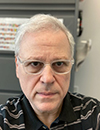Gerardo Kaplan,
Principal Investigator
Dr. Kaplan received a Doctoral Degree in Biology from the University of Buenos Aires, Argentina. As a Postdoctoral Fellow at Columbia University, NYC, he studied different aspects of poliovirus (PV) biology including mapping the first IRES that conferred cap-independent translation, developing the first subgenomic replicons, and selecting PVR neutralization-resistant mutants to understand the PV-PVR interaction. In the early 90s, Dr. Kaplan joined the Center for Biologics Evaluation and Research (CBER) of the Food and Drug Administration (FDA) as a tenure-track investigator. At CBER, he discovered the hepatitis A virus (HAV) cellular receptor 14, the first identified member of a family of molecules that modulate asthmatic, autoimmune, and graft-versus-host disease, anti-viral, and anti-cancer immune responses. He was tenured at CBER in 1998 due to his contributions to the HAV filed and regulatory work leading to the licensing of HAV vaccines. From 2001 to 2008, he served as the Chief of the Laboratory of Hepatitis and Related Emerging Agents at the Office of Blood Research and Review (OBRR), CBER. At OBRR, his work contributed to the identification of members of the HAVCR family (also referred as TIM family) as pattern recognition receptors (PRR) of phosphatidylserine, showed that the interaction of HAV with HAVCR1 on regulatory T cells (Treg) blocks T-cell receptors, shuts off Treg function, and controls the pathogenic process of HAV7. In response to the FDA need to gain expertise in bioterrorism agents, Dr. Kaplan developed a filovirus program focused on vaccines based on the viral glycoprotein (GP) and BSL2 tests to evaluate anti-GP total and neutralizing antibodies. Dr. Kaplan is currently a Principal Investigator at the Lab of Molecular Virology, CBER-FDA and an Affiliated Faculty at George Mason University. He continuous working in pathogenesis of HAV and the role of HAVCR1 in cell entry of viruses and exosomes.
|

|
